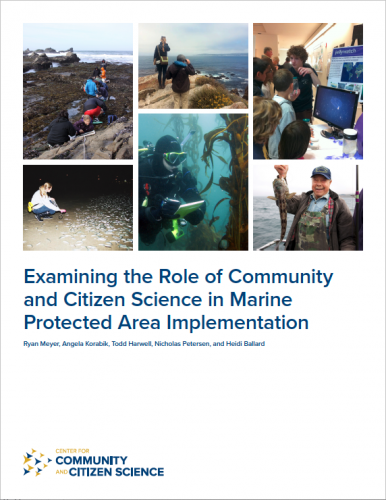New reports on Community and Citizen Science in California’s Marine Protected Areas
The Center’s analyses will inform the California Department of Fish and Wildlife’s Decadal Management Review of MPAs
Since Spring 2021, two project teams at the UC Davis Center for Community and Citizen Science have been collecting and analyzing data related to the contributions of community and citizen science participants in coastal monitoring activities within and surrounding marine protected areas (MPAs) throughout the State of California. At the end of January, these efforts culminated in two reports that were submitted to the California Department of Fisheries and Wildlife (CDFW) as contributions to the MPA Decadal Management Review process, for which CDFW is compiling a comprehensive report to inform the California Fish and Game Commission in their plans for the next 10 years of the state’s MPA Management Plan.
Examining the Role of Community and Citizen Science in Marine Protected Area Implementation
Community and citizen science (CCS), which refers to the wide range of ways that nonscientists participate in science processes, has played a prominent role in MPA implementation and monitoring in the State of California for more than a decade. This report highlights the breadth and depth of how CCS efforts have contributed to MPA program priorities and goals as well as participant contributions and outcomes. Since 2007, the California Department of Fish and Wildlife (CDFW), California Ocean Protection Council (OPC), and the California Fish and Game Commission have collaborated to manage California’s MPA Monitoring Program, which has included a wide-ranging portfolio of projects that received state funding to conduct both Baseline and Long-Term Monitoring. Some of these projects have leveraged CCS approaches to administer their monitoring and research activities.
In this report, we examined the CCS efforts of 10 MPA monitoring projects that received baseline and/or long-term funding from the State. Over the past decade, these projects involved:
Beyond those 10, there are well over 60 other CCS projects conducting research and monitoring along the California coast. Based on the results of an online survey, we found that between 2010 and 2020:
- 29 of those additional projects involved > 70,000 participants working with over 200 organizational partners.
- 21 projects collected data inside MPAs in California.
- 12 projects provided participants with information about MPAs.
For a more detailed account of our findings, please review the full CCS in MPAs Report.
Using MPA Watch Data to Analyze Human Activities Along the California Coast
With funding from OPC, the Center partnered with the UC Davis Center for Environmental Policy and Behavior and the UC Davis Data Lab in a project focused specifically on the MPA Watch network, which monitors human use of MPAs and other sites along the coast. Since 2011 volunteer surveyors working with MPA Watch have collected more than 30,000 surveys of human activities such as boating, onshore fishing, and tidepooling. Our team summarized and analyzed these data, looking for patterns in coastal use.
Of the activities observed by the surveyors, non-consumptive activities vastly outnumbered consumptive activities, both inside and outside of MPAs. This highlights the value of MPA Watch data for understanding human coastal use, underscores the importance of recreational activities in California’s coastal economy, and reinforces the need to monitor and understand non-consumptive uses in and around MPAs.
Our statistical analysis of these observations used occupancy modeling to investigate occurrence probabilities for seven categories of human activity. These models focus on an activity’s likelihood of occurrence, rather than the total number of occurrences. Occupancy modeling also helps to account for differences over time and space in how many surveyors have contributed their observations, which have varied systematically as the program has grown over the decade. This analysis demonstrated that MPA Watch data can be successfully used to detect statistically significant differences between activities inside and outside of MPAs. Specifically, from 2012 to 2020 at the statewide level:
This analysis is a first step towards probing what the MPA Watch dataset can tell us about human coastal use. As the surveyors’ observations extend beyond the nine years in our analysis, time trends in activities may become apparent, and further models could focus on questions about how the characteristics of individual MPAs might affect human use, as well as investigating more detailed within-year patterns in human use. Our summaries and analysis also pointed to the importance of updating protocols for recording potential violations of MPA rules, in collaboration with the California Department of Fish and Wildlife.
We also see potential for the MPA Watch network to be leveraged as part of a broader strategy for human dimensions research and monitoring. The combination of CCS data from MPA Watch and sophisticated statistical modeling shows great promise for answering questions about statewide patterns in coastal use.
See the MPA Watch Analysis Report for more details.












